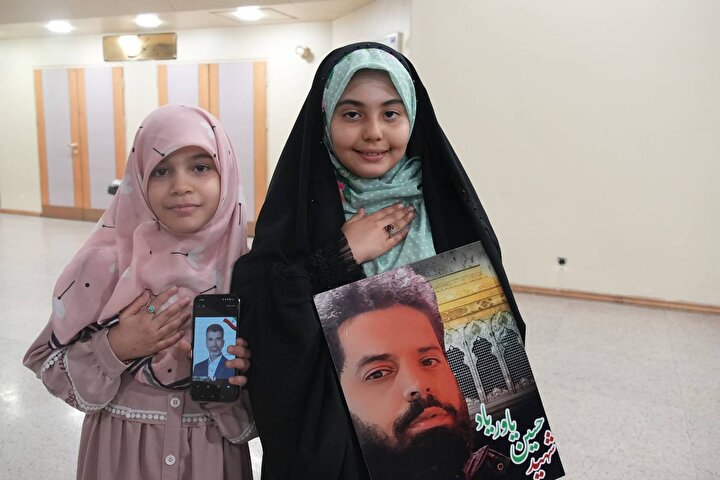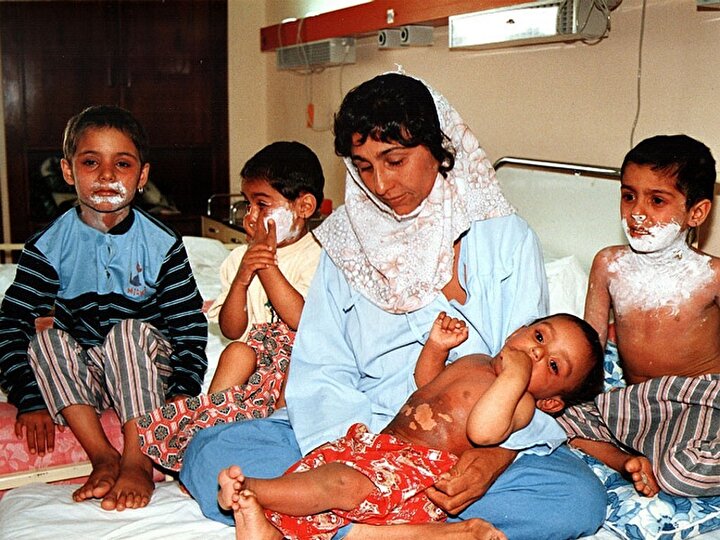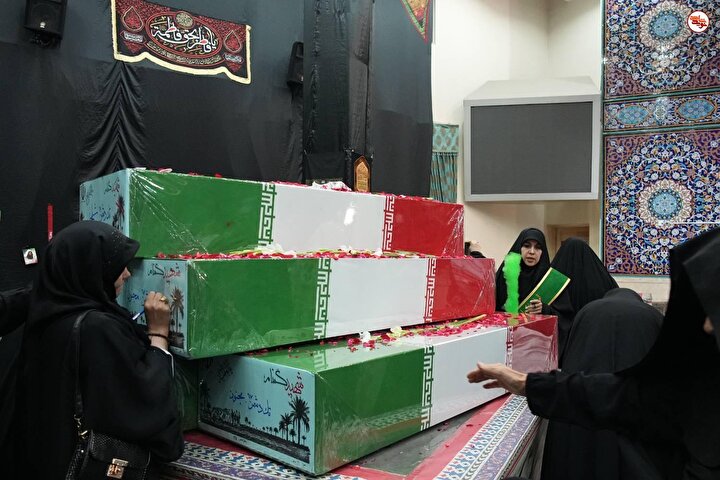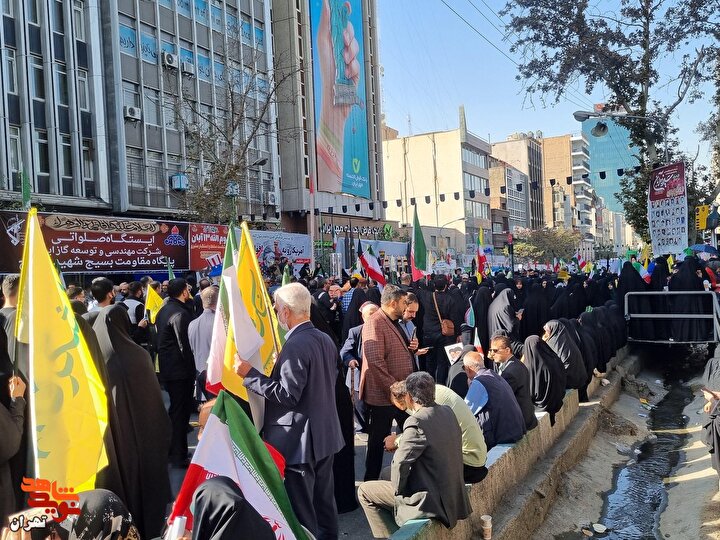
A Review on Concepts of Self Sacrifice and Martyrdom in Posters of Islamic Revolution Artists
In continuation of activities during the first and second decades of Islamic Revolution, Graphic artists have always made efforts to show humanitarian and spiritual values with their pictorial art works. Their concerns have been mostly reflected in the following two general sections: The first one is appearance of the concepts of Isargaran and martyrs to people in general and the second one is developing the art of graphic in order to achieve to Iranian – Islamic identity.
But, we should think more deeply about how they have achieved to their objectives.
Therefore, the current article intends to find the answers to following questions:
1: How have committed and revolutionary artists pictured the concepts of self sacrifice and martyrdom?
2: In development of the art of graphic, what new plans and ideas did these artists present in order to achieve Iranian- Islamic identity?
3: What sectors of the society were the audiences of artists of Islamic Revolution? And what effects did these audiences take from symbolic drawings which exist in posters?
Method of Research
General method of research in this article is chosen based on descriptive and analytic approach.
Introductory:
The Words “Self Sacrifice”? and “Martyrdom”? have special holiness and position in Islam. In this religion, martyrdom is a red death based on knowledge and awareness that human chooses with his all logic and awareness and devotes his life or a part of his body in the way of divine and humanitarian high values.
Certainly, this way of thinking has appeared in every historical period of time. And thinkers and artists have surely paid special attention to this holy subject. Every thinker and artist has respected to this high position with his own language and art of writing. And they have pictured this concept with their own way of thinking.
Among all these people, artists including graphic artists have made efforts to show these values with their own pictorial expression. They have found art as the best medium for propagating love, martyrdom and self sacrifice.
To this end, graphic artists have benefited from visual signs for establishing a visual connection and transferring a particular message. They have reflected this spiritual aspect through the art of “Poster”?. Graphic artists have made efforts to be the propagator of the culture of self sacrifice and martyrdom to common people.
To this end, after appearance of Islamic Revolution, the most activities were carried out by a group of committed artists who were members of Islamic Propagation Organization. And considerably good art works were created by them.
They believe that although it is not possible to picture smell of a destroyed rose bud or show the self sacrifice of a human in the way of God, it is possible to picture them relying on belief and love. In parts of writings written by this group of graphic artists we read as follows: “How can we begin a difficult journey full of dangers with picture, line and drawing? How can we inform people about rising a sun?
Although it is impossible, but the impossible bows head where love commands. We started this way based on the command of love. May our pens and paintbrushes take color from God and take movement from the blessing of belief. (Aali, 1365:5)”?
With this view, we witnessed activities of this group of committed young artists. This group made efforts to transfer the concepts of self sacrifice and martyrdom and their spiritual values in the framework of graphic art, poster art in particular to common people during 1360 (1980’s) and 1370 (1990’s) decades.
Art of graphic is a collection of pictorial art works which can be published in a large scale. These pictorial works transfer special message to audiences by benefiting visually from poster, sign, drawing letters, drawing pictures for books, etc.
Being published and being able to announce the particular message to other people is one of the important characteristics of graphic art. This art was formed in 18th century by using lithography (Stone printing) and considering low expense facilities of lithography.
And due to speedy and suitable information dissemination to common people, this art changed into one of the unique visual arts among other media.
The approximate 100 year history of modern graphic in Iran shows that artists in this field have been influenced by some visual and literary elements of simplifying, changing forms and making symbols and then established a separated branch of this art under the title of art of graphic. This important event caused appearance of a new movement in the field of visual arts in our country. And some outstanding artists were inspired by Iranian arts and the contemporary art of the world after 1330 decade (1950’s) and tried to create attractive art works in the field of graphic.
In this process and following the appearance of Islamic Revolution in 1357 (1979), the art of graphic faced with cultural and political changes. This change paved new grounds for growth and development of this art. After fall of Pahlavi Government and appearance of Islamic Revolution, some people used graphic in advertising and commercial fields. And some others used this art in cultural fields. Another group used this live visual language in service of objectives and ideals of Islamic Revolution. This group stabilized this art in the form of Islamic Revolution Graphic.
Many of young artists committed to Islamic Revolution started new round in order to move parallel with Islamic culture. They made efforts to announce clearly their serious presence by using symbolic and coded models risen from the heart of Islamic Revolution events and mix it with traditional models of art in past.
They mostly tried to picture religious subjects and/or the subjects that were rooted in Islamic Revolution and the imposed war; but their practical method is the method of social realists during the decades of 1920’s and 1930’s after the World War I.
Writer: Mohammad A’zam-zadeh
The Words “Self Sacrifice”? and “Martyrdom”? have special holiness and position in Islam. In this religion, martyrdom is a red death based on knowledge and awareness that human chooses with his all logic and awareness and devotes his life or a part of his body in the way of divine and humanitarian high values.
Certainly, this way of thinking has appeared in every historical period of time. And thinkers and artists have surely paid special attention to this holy subject. Every thinker and artist has respected to this high position with his own language and art of writing. And they have pictured this concept with their own way of thinking.
Among all these people, artists including graphic artists have made efforts to show these values with their own pictorial expression. They have found art as the best medium for propagating love, martyrdom and self sacrifice.
To this end, graphic artists have benefited from visual signs for establishing a visual connection and transferring a particular message. They have reflected this spiritual aspect through the art of “Poster”?. Graphic artists have made efforts to be the propagator of the culture of self sacrifice and martyrdom to common people.
To this end, after appearance of Islamic Revolution, the most activities were carried out by a group of committed artists who were members of Islamic Propagation Organization. And considerably good art works were created by them.
They believe that although it is not possible to picture smell of a destroyed rose bud or show the self sacrifice of a human in the way of God, it is possible to picture them relying on belief and love. In parts of writings written by this group of graphic artists we read as follows: “How can we begin a difficult journey full of dangers with picture, line and drawing? How can we inform people about rising a sun?
Although it is impossible, but the impossible bows head where love commands. We started this way based on the command of love. May our pens and paintbrushes take color from God and take movement from the blessing of belief. (Aali, 1365:5)”?
With this view, we witnessed activities of this group of committed young artists. This group made efforts to transfer the concepts of self sacrifice and martyrdom and their spiritual values in the framework of graphic art, poster art in particular to common people during 1360 (1980’s) and 1370 (1990’s) decades.
Art of graphic is a collection of pictorial art works which can be published in a large scale. These pictorial works transfer special message to audiences by benefiting visually from poster, sign, drawing letters, drawing pictures for books, etc.
Being published and being able to announce the particular message to other people is one of the important characteristics of graphic art. This art was formed in 18th century by using lithography (Stone printing) and considering low expense facilities of lithography.
And due to speedy and suitable information dissemination to common people, this art changed into one of the unique visual arts among other media.
The approximate 100 year history of modern graphic in Iran shows that artists in this field have been influenced by some visual and literary elements of simplifying, changing forms and making symbols and then established a separated branch of this art under the title of art of graphic. This important event caused appearance of a new movement in the field of visual arts in our country. And some outstanding artists were inspired by Iranian arts and the contemporary art of the world after 1330 decade (1950’s) and tried to create attractive art works in the field of graphic.
In this process and following the appearance of Islamic Revolution in 1357 (1979), the art of graphic faced with cultural and political changes. This change paved new grounds for growth and development of this art. After fall of Pahlavi Government and appearance of Islamic Revolution, some people used graphic in advertising and commercial fields. And some others used this art in cultural fields. Another group used this live visual language in service of objectives and ideals of Islamic Revolution. This group stabilized this art in the form of Islamic Revolution Graphic.
Many of young artists committed to Islamic Revolution started new round in order to move parallel with Islamic culture. They made efforts to announce clearly their serious presence by using symbolic and coded models risen from the heart of Islamic Revolution events and mix it with traditional models of art in past.
They mostly tried to picture religious subjects and/or the subjects that were rooted in Islamic Revolution and the imposed war; but their practical method is the method of social realists during the decades of 1920’s and 1930’s after the World War I.
Writer: Mohammad A’zam-zadeh



